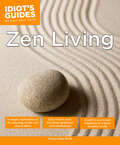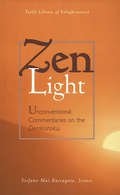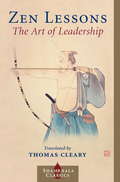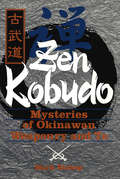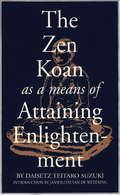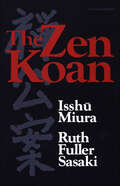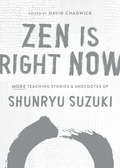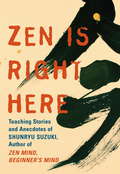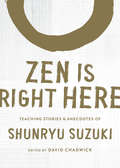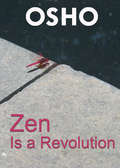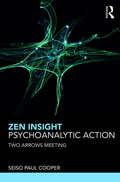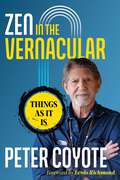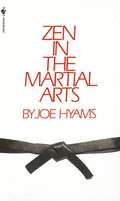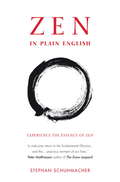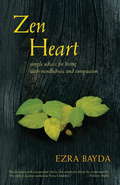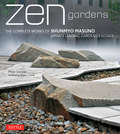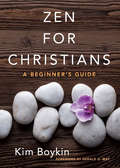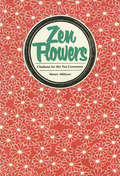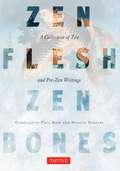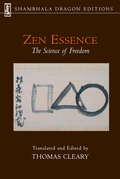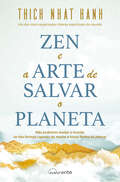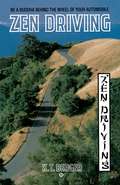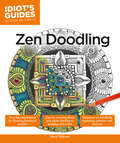- Table View
- List View
Zen Living: A Simple Explanation of the Meaning of Zen and What It Offers (Idiot's Guides)
by Domyo Sater BurkIn today's fast-paced, technology-laden society, it's easy to become overwhelmed. People seek calm and simplicity, but have a hard time realizing a "Zen" life. Monk and sensei Domyo Sater Burk illustrates how to get started on the path to peace and enlightenment, regardless of cultural or religious affiliation. You'll learn the foundation and essential teachings of Zen practice, how to engage in meditation and mindfulness, and how to live daily within a Zen moral code.
Zen Light
by Stefano Mui BarragatoThe Denkoroku, or "Record of Transmitting the Light," contains the enlightenment stories of the earliest Zen ancestors. In Zen Ught, the author comments on this Buddhist classic, which he studied as part of his own advanced Zen training. Sensei Barragato brings the varied experiences of his life and his studies in Catholicism and Quaker practice to the teachings of Zen Buddhism, making these commentaries at once off-beat, refreshing, and revealing. He touches on the major issues that affect our lives, making thisbook of interest to both the beginning as well as the advanced student of Zen.
Zen Light
by Stefano Mui BarragatoThe Denkoroku, or "Record of Transmitting the Light," contains the enlightenment stories of the earliest Zen ancestors. In Zen Ught, the author comments on this Buddhist classic, which he studied as part of his own advanced Zen training. Sensei Barragato brings the varied experiences of his life and his studies in Catholicism and Quaker practice to the teachings of Zen Buddhism, making these commentaries at once off-beat, refreshing, and revealing. He touches on the major issues that affect our lives, making thisbook of interest to both the beginning as well as the advanced student of Zen.
Zen Lessons: The Art of Leadership
by Thomas ClearyThis guide to enlightened conduct for people in positions of authority is based on the teachings of several great Chinese Zen masters. Drawing on private records, letters, and long-lost documents of the Song dynasty (tenth to thirteenth centuries), Zen Lessons consists of short excerpts written in language that is accessible to the reader without any background in Eastern philosophy. This book serves as a guide to recognizing the qualities of a genuine Zen teacher; it also serves as a study of the character and conduct necessary for the mastery of any position of power and authority--whether religious, social, political, or organizational.
Zen Kobudo
by Mark BishopKobudo, the famous armed Okinawan fighting art that utilizes common farming implements in combat, and Te, the ancient Okinawan art of armed and unarmed combat, are two of the world's most widely practiced yet least-understood martial arts. This book studies the individual Kobudo and Te systems as they are practiced in Okinawa today and discusses their various histories and the lives of the masters who have most influenced them. Spiritualism in the Okinawan arts is also covered in detail, as the author masterfully describes the mix of Zen and native beliefs that are vital to these arts, yet a component that has been all but ignored by previous researchers. In addition, this is the first work to discuss anthropological theories on Okinawa and the development of fighting arts there from the Stone Age. This complete and wide-ranging study of Okinawan weaponry, history, and training is the ultimate guide to these important fighting arts.
Zen Kobudo
by Mark BishopKobudo, the famous armed Okinawan fighting art that utilizes common farming implements in combat, and Te, the ancient Okinawan art of armed and unarmed combat, are two of the world's most widely practiced yet least-understood martial arts. This book studies the individual Kobudo and Te systems as they are practiced in Okinawa today and discusses their various histories and the lives of the masters who have most influenced them. Spiritualism in the Okinawan arts is also covered in detail, as the author masterfully describes the mix of Zen and native beliefs that are vital to these arts, yet a component that has been all but ignored by previous researchers. In addition, this is the first work to discuss anthropological theories on Okinawa and the development of fighting arts there from the Stone Age. This complete and wide-ranging study of Okinawan weaponry, history, and training is the ultimate guide to these important fighting arts.
Zen Koan as a Means of Attaining Enlightenment
by Daisetz Teitaro SuzukiZen Koan as a Means of Attaining Enlightenment Presents the history and application of the koan exercise--the means for realizing enlightenment--with depth and clarity.<P><P>The koan system has effected a special development in Zen Buddhism, and is a unique contribution to the history of religious consciousness. When the importance of the koan is understood, it may be said that more than half of Zen is understood.
The Zen Koan: Its History and Use in Rinzai Zen
by Isshu Miura Ruth Fuller SasakiThe first scholarly examination in any language of the historical development and traditional method of koan study in Zen Buddhism. Foreword by Ruth Fuller Sasaki; Index; ink drawings by Hakuin Ekaku.A Helen and Kurt Wolff Book.
Zen Is Right Now: More Teaching Stories and Anecdotes of Shunryu Suzuki, Author of Zen Mind, Beginner's Mind
by Shunryu SuzukiIn this new collection of quotes from Shunryu Suzuki Roshi and stories from his students, the presence, wisdom, and humor of a great Zen teacher come alive once more.The teachings of Shunryu Suzuki have served for innumerable people as the gateway to Zen practice and meditation. In Zen Is Right Now, devoted student and biographer David Chadwick sheds new light on Suzuki&’s presence and teachings through selected quotes from his lectures and a variety of stories told by his students. Complementary to another collection about Suzuki, Zen Is Right Here, this book offers a joyful bounty of anecdotes and insights, revealing a playful and deeply wise teacher who delighted in paradox and laughed often. Each of the stories and quotes presented here is an example of the versatile and timeless quality evident in Suzuki&’s teaching, showing that the potential for attaining enlightenment exists right now, in this very moment.
Zen Is Right Here: Teaching Stories and Anecdotes of Shunryu Suzuki, Author of Zen Mind, Beginner's Mind
by David ChadwickShunryu Suzuki's extraordinary gift for conveying traditional Zen teachings using ordinary language is well known to the countless readers of Zen Mind, Beginner's Mind. In Zen Is Right Here, his teachings are brought to life powerfully and directly through stories told about him by his students. These living encounters with Zen are poignant, direct, humorous, paradoxical, and enlightening; and their setting in real-life contexts makes them wonderfully accessible. Like the Buddha himself, Suzuki Roshi gave profound teachings that were skilfully expressed for each moment, person, and situation he encountered. He emphasized that while the ungraspable essence of Buddhism is constant, the expression of that essence is always changing. Each of the stories presented here is an example of this versatile and timeless quality, showing that the potential for attaining enlightenment exists right here, right now, in this very moment.
Zen Is Right Here: Teaching Stories and Anecdotes of Shunryu Suzuki, Author of Zen Mind, Beginner's Mind
by Shunryu SuzukiPersonal stories and anecdotes of the trailblazing Zen teacher Suzuki Roshi--now reissued in hardcover in tandem with the publication of the follow-up volume, Zen Is Right Now. Shunryu Suzuki&’s extraordinary gift for presenting traditional Zen teachings using ordinary language is well known to the countless readers of Zen Mind, Beginner&’s Mind. In Zen Is Right Here, his teachings are brought to life through stories told by his students. These living encounters with Zen are poignant, direct, humorous, paradoxical, and enlightening—and their setting in real-life contexts makes them wonderfully accessible. Like the Buddha himself, Shunryu Suzuki gave profound teachings that were skillfully expressed for each moment, person, and situation he encountered. He emphasized that while the essence of Buddhism is constant, the expression of that essence is always changing. Each of the stories presented here is an example of this versatile and timeless quality, showing that the potential for attaining enlightenment exists right here, at this very place.
Zen Is a Revolution
by Osho Osho International FoundationIn this talk Osho takes his audience into the world of ZEN. "There are a few essential things which make Zen absolutely different from any kind of teaching. The most important of these essentials is that Zen is a revolution. All other religions are servants to the vested interests. The rich people and the powerful people, the politicians, have dominated all the religions. The priests have been nothing but servants to these criminals. It is such a worldwide conspiracy that no one recognizes it. It is so obvious and so simple that we are from the very beginning, from our very childhood, being programmed." From an original series: Rinzai: Master of the Irrational, by Osho.
Zen Insight, Psychoanalytic Action: Two Arrows Meeting
by Seiso Paul CooperDrawing from original source material, contemporary scholarship, and Wilfred Bion’s psychoanalytic writings, Zen Insight, Psychoanalytic Action: Two Arrows Meeting introduces the Zen notion of "gūjin," or total exertion, and elaborates a realizational perspective that integrates Zen Buddhism and psychoanalysis. Developed by the thirteenth century Zen teacher and founder of the Japanese Soto Zen school, Eihei Dogen, gūjin finds expression and is referenced in various contemporary scholarly and religious commentaries. This book explains this pivotal Zen concept and addresses themes by drawing from translated source material, academic scholarship, traditional Zen kōans and teaching stories, extensive commentarial literature, interpretive writings by contemporary Soto Zen teachers, psychoanalytic theory, clinical material, and poetry, as well as the author’s thirty years of personal experience as a psychoanalyst, supervisor, psychoanalytic educator, ordained Soto Zen priest, and transmitted Soto Zen teacher. From a realizational perspective that integrates Zen and psychoanalytic concepts, the book addresses anxiety-driven interferences to deepened Zen practice, extends the scope and increases the effectiveness of clinical work for the psychotherapist, and facilitates deepened experiences for both the Buddhist and the secular meditation practitioner. Two Arrows Meeting will be of great interest to researchers in the fields of Zen Buddhism and psychoanalysis. It will also appeal to meditation practitioners and psychoanalysts in practice and training.
Zen in the Vernacular: Things As It Is
by Peter Coyote• Shows how Zen offers a creative problem-solving mechanism and moral guide ideal for the stresses and problems of daily life• Shares the author&’s secular, vernacular interpretations of the Four Noble Truths, the Three Treasures, the Eightfold Path, and other fundamental Buddhist ideasDuring the nearly 3,000 years since the Buddha lived, his teachings have spread widely around the globe. In each culture where Buddhism was introduced, the Buddha&’s teachings have been pruned and modified to harmonize with local customs, laws, and cultures. We can refer to these modifications as &“gift wrapping,&” translating the gifts of Buddha&’s teachings in ways sensible to particular cultures in particular times. This gift-wrapping explains why Indian, Tibetan, Vietnamese, Japanese, Chinese, and Indonesian Buddhism have significant differences.In this engaging guide to Zen Buddhism, award-winning actor, narrator, and Zen Buddhist priest Peter Coyote helps us peer beneath the Japanese gift-wrapping of Zen teachings to reveal the fundamental teachings of the Buddha and show how they can be applied to contemporary daily life. The author explains that the majority of Western Buddhists are secular and many don&’t meditate, wear robes, shave their heads, or believe in reincarnation. He reminds us that the mental/physical states achieved by Buddhist practice are universal human states, ones we may already be familiar with but perhaps never considered as possessing spiritual dimensions.Exploring Buddha&’s core teachings, the author shares his own secular and accessible interpretations of the Four Noble Truths, the Three Treasures, and the Eightfold Path within the context of his lineage and the teachings of his teacher and the teachers before him. He looks at Buddha&’s teachings on our singular reality that appears as a multiplicity of things and on the &“self&” that perceives reality, translating powerful spiritual experience into the vernacular of modern life.Revealing the practical usefulness of Buddhist philosophy and practice, Zen in the Vernacular shows how Zen offers a creative problem-solving mechanism and moral guide ideal for the stresses and problems of everyday life.
Zen in the Martial Arts
by Joe Hyams"A man who has attained mastery of an art reveals it in his every action. "--Samurai Maximum. Under the guidance of such celebrated masters as Ed Parker and the immortal Bruce Lee, Joe Hyams vividly recounts his more than 25 years of experience in the martial arts. In his illuminating story, Hyams reveals to you how the daily application of Zen principles not only developed his physical expertise but gave him the mental discipline to control his personal problems-self-image, work pressure, competition. Indeed, mastering the spiritual goals in martial arts can dramatically alter the quality of your life-enriching your relationships with people, as well as helping you make use of all your abilities.
Zen in Plain English
by Stephan SchuhmacherNo other book quite engages the reader in the kinds of perceptions and experiences that the seeker will have while following this path. The Zen masters are famous for their unorthodox ways of teaching the wisdom of the 'thing itself'. Their Koans - paradoxical stories, and questions - are designed to rid the mind of over-sophisticated responses. A selection of tales from the great Zen teachers, this book coaxes the reader into a direct encounter with the life-changing perceptions of the Zen mind. Challenging us to find 'a solution that resolves and dissolves the knots in heart and mind, the chronic cramp that prevents us from breathing freely, from giving ourselves without reserve to life in all its delightful and painful facets, and from being at peace with life and with death.' In this process we are confronted by the limits of rational meaning - and we begin to understand why Zen masters use humour and paradox to lead us to the very edge of the precipice of reason, and why, at that critical point, we are gently pushed over.'Stephan Schumacher's innovative format and his fresh interpretations of this fine selection of stories from the great teachers are a useful introduction to Zen practice, and more importantly a welcome return to the fundamental Dharma of no-self, not-knowing, the thing- itself and the beauty and precision of this moment-by-moment precious moment of our lives.' Peter Matthiessen(Muryo Roshi)
Zen Heart: Simple Advice for Living with Mindfulness and Compassion
by Ezra BaydaThere's a secret to spiritual practice, and it's surprisingly simple: learn to be present with attention. Do that, and the whole world becomes your teacher, you wake up to the sacredness of every aspect of existence, and compassion for others arises without even thinking about it. In Zen Heart, Bayda provides a wealth of practical advice for making difficult experiences a valued part of the path and for making mindfulness a daily habit.
Zen Gardens
by Mira Locher Uchida ShigeruShunmyo Masuno, Japan's leading garden designer, is at once Japan's most highly acclaimed landscape architect and an 18th-generation Zen Buddhist priest, presiding over daily ceremonies at the Kenkoji Temple in Yokohama. He is celebrated for his unique ability to blend strikingly contemporary elements with the traditional design vernacular. He has worked in ultramodern urban hotels and in some of Japan's most famous classic gardens. In each project, his work as a designer is inseparable from his Buddhist practice. Each becomes a Zen garden, "a special spiritual place where the mind dwells."This beautiful book, illustrated with more than 400 drawings and color photographs, is the first complete retrospective of Masuno's work to be published in English. It presents 37 major gardens around the world in a wide variety of types and settings: traditional and contemporary, urban and rural, public spaces and private residences, and including temple, office, hotel and campus venues. Masuno achieved fame for his work in Japan, but he is becoming increasingly known internationally, and in 2011 completed his first commission in the United States which is shown here.The book, divided into three chapters, covers: "Traditional Zen Gardens," "Contemporary Zen Gardens," and "Zen Gardens outside Japan." Illustrated with photographs and architectural plans or sketches, each garden is described and analyzed by author Mira Locher, herself an architect and a scholar well versed in Japanese culture.Celebrating the accomplishments of a major, world-class designer, Zen Gardens also serves as something of a master class in Japanese garden design and appreciation: how to perceive a Japanese garden, how to understand one, even how to make one yourself. Like one of Masuno's gardens, the book can be a place for contemplation and mindful repose.
Zen for Christians: A Beginner's Guide
by Gerald G. May Kim Boykin"Whereas other Christianity-meets-Buddhism books stress ideology and the intellect, this one emphasizes daily acts of practice." — Publishers Weekly (starred review) In this illuminating and insightful guide, Kim Boykin offers Christians a way to incorporate Zen practices into their lives without compromising their beliefs and faith.Zen for Christians assumes curiosity but no real knowledge as it walks readers through specific concepts of Zen philosophy — including suffering, attachment, and enlightenment — and explains each in a simple but lively way. Sections between chapters gently demonstrate Zen meditation practices, explaining the basics in a clear, engaging manner. Placing Buddhist and Christian teachings side by side helps readers not only understand Zen but also shows their compatibility. Drawing on Dr. Boykin's own personal search through Buddhism and Christianity as well as her background in theological studies, this thought-provoking work illustrates how Zen practice can be particularly useful for Christians who want to enrich their faith by incorporating contemplative practices."An excellent introduction to Zen — clear and to the point, practical, respectful, and even humorous at times." — Yoga Journal "Makes Zen practice more approachable and less esoteric … a straightforward guide for those who want to try Zen for themselves." — Monastic Interreligious Dialogue Bulletin "A trustworthy and delightful guide. Kim Boykin will demystify and deepen your understanding of both the traditions she practices. A gem!" — James W. Fowler, author, Stages of Faith "Kim Boykin writes in the skilled language of simplicity. While addressing those new to Zen, she offers practical wisdom, challenge, and encouragement to all practitioners." — Rose Mary Dougherty, Shalem Institute for Spiritual Formation, Bethesda, Maryland "The great religions of the world have much to learn from each other. Kim Boykin's book is a skillful step in that direction. The heart of the matter of Zen is presented in a direct and informative way that is based on her firsthand experience of Zen training. This should prove to be a helpful guidebook for any Christian who wishes to explore Zen practice." — John Daido Loori, roshi, abbot, Zen Mountain Monastery "This lovely, wise, and practical introduction to Zen keeps its promise of companionship as the kind of spiritual cookbook you can bring right into the kitchen. Recipe-reading like this, in fact, inspires you to get into the kitchen, encourages you to keep at it, and invites you to share your efforts in communion with others." — Steven Tipton, coauthor, Habits of the Heart "An excellent resource on Zen practice, written from a pragmatic, personal, and yet sophisticated point of view. What a fine contribution to Buddhist-Christian understanding!" — Judith Simmer-Brown, coauthor, Benedict's Dharma: Buddhists Comment on the Rule "This is a good-humored, intelligent, nonguilt-inducing book written by a person who shows us clearly what it would be like to reap the benefits of what she preaches." — Roberta Bondi, author, Memories of God and Houses: A Family Memoir of Grace
Zen Flowers: Chabana for the Tea Ceremony
by Henry MittwerThis Zen flower arranging book teaches the delicate art of Japanese Chabana--the precursor to ikebana.<P><P>Up to now, with the exception of Okakura Kakuzo's excellent account of flowers used in the art of Chanoyu in his delightful The Book of Tea, almost nothing has been available on the subject. To my knowledge, the present volume is the only book written in English that is wholly devoted to the special form of flower arrangement called Chabana.Chabana is a type of flower arrangement that originated in the tea room . Chabana is not only for decoration, for symbolic representation, or for abstract expression of the self. 2,500years ago, Chabana has something in common with one of Shakyamuni Buddha's sermons. Buddha lightly picked a single bloom from a basketful of flowers offered to Him by one of the multitude who came to hear His sermon. Buddha slowly, silently, held up the flower before the congregation. Among the gathering was one of His disciples, Mahakasyapa, who gently smiled as he apprehended the Buddha's gesture. Chabana may not be a flower arrangement having a Zen-like mission, but it certainly is a flower arrangement appreciated by a mind nourished with the Zen principles of simplicity and directness.
Zen Flesh, Zen Bones: A Collection of Zen and Pre-Zen Writings
by Paul Reps Nyogen Senzaki"Zen Flesh, Zen Bones" is four books in one - books that would rank high in the canon of Zen, if Zen were so non-Zen as to have scriptures. "101 Zen Stories" recounts experiences of Chinese and Japanese Zen teachers over a period of more than five centuries. "The Gateless Gate" offers a collection of 13th-century koans to sit with in practice. "10 Bulls" is a 12th-century commentary on the stages of awareness leading to enlightenment. Finally "Centering," a 4,000 year-old teaching from India, offers what some would consider to be the roots of Zen. When this book was first published in 1957 it became a guide for an entire generation of western seekers who were just beginning to explore Zen. In the years since it has inspired leading American Zen teachers, students, and practitioners. Join them.
Zen Essence
by Thomas ClearyDrawn from the records of Chinese Zen masters of the Tang and Song dynasties, this collection may surprise some readers. In contrast to the popular image of Zen as an authoritarian, monastic tradition deeply rooted in Asian culture, these passages portray Zen as remarkably flexible, adaptive to contemporary and individual needs, and transcending cultural boundaries.The readings contained in Zen Essence emphasize that the practice of Zen requires consciousness alone and does not depend on a background in Zen Buddhism and Asian culture. The true essence of Zen resides in the relationship between mind and culture, whatever that culture might be. This unique collection of writings creates a picture of Zen not as a religion or philosophy, but as a practical science of freedom.
Zen e a Arte de Salvar o Planeta
by Thich Nhat HanhO livro mais recente de um dos mais respeitados líderes espirituais do mundo. Não podemos mudar o mundo se não formos capazes de mudar a nossa forma de pensar. Atualmente, enfrentamos uma poderosa interseção de crises: destruição ecológica, colapso climático, aumento da desigualdade, injustiça racial e os impactos duradouros de uma pandemia devastadora. Para enfrentarmos estes desafios, precisamos de encontrar formas de fortalecer a nossa lucidez, compaixão e coragem para agir. A mensagem de Thich Nhat Hanh é muito clara: existe algo que temos o poder de mudar, que fará toda a diferença, e esse algo é a nossa mente. A nossa forma de olhar e de pensar as coisas determina as ações e decisões que tomamos ou evitamos, como nos relacionamos com aqueles que amamos ou de quem discordamos, e como reagimos numa crise. O mindfulness e as visões decisivas da meditação podem ajudar-nos a criar um mundo regenerativo em que todas as vidas sejam respeitadas. Zen e a Arte de Salvar o Planeta mostra-nos uma nova forma de viver e de trazer harmonia a nós próprios, aos nossos relacionamentos e à Terra. «Precisamos de despertar juntos e, se despertarmos juntos, teremos uma hipótese. A nossa forma de viver e planear o futuro conduziu-nos a esta situação. E agora precisamos de olhar profundamente para encontrarmos uma solução, não apenas como indivíduos, mas como um coletivo, uma espécie.» — Thich Nhat Hanh «Thich Nhat Hanh mostra-nos a íntima ligação entre uma pessoa, a sua paz interior e a paz no mundo.» Dalai Lama «Pode ser difícil manter uma atitude positiva e sentir esperança. Neste livro, o monge vietnamita, professor, autor, poeta e ativista da paz, Thich Nhat Hanh, aplica a sabedoria budista à vida quotidiana, ajudando os leitores a fazerem as pazes com o seu lugar no mundo e dando-lhes as ferramentas para aceitarem as circunstâncias que fogem de seu controlo.» Booklist
Zen Driving: Be a Buddha Behind the Wheel of Your Automobile
by K. T. BergerBe a buddha behind the wheel of your automobile.
Zen Doodling (Idiot's Guides)
by David WilliamsDoodling isn't necessarily a mindless pursuit. There's hidden discipline, order, and joy behind artful scribbles. Idiot's Guides: Zen Doodling gives readers beautiful, full-color instruction and all they need to start using ordered, repeated "tangle" designs that are great creative expressions and works of art unto themselves. The book includes step-by-step instructions for drawing more than 20 doodle forms and patterns.
